If you asked me to DJ right now, this is what it would be like:
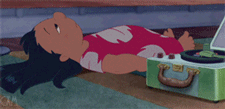
MLX11. Best Australian exchange of all time. Of all time. Best bands. Best DJs. Best fun DJing. I feel inspired again.
But right now. I’m so tired. I’m so tired.
If you asked me to DJ right now, this is what it would be like:

MLX11. Best Australian exchange of all time. Of all time. Best bands. Best DJs. Best fun DJing. I feel inspired again.
But right now. I’m so tired. I’m so tired.
Just as I finished posting that last ranty mcrantington rant about DJing (NEEDS MOAR DJS ? (part 2) (Thursday, November 17th, 2011)) there was a flurry of emailing and suddenly, DJing in Sydney gets very interesting. This is a post about getting into DJing in Sydney. Which is suddenly, thanks to the generosity of quite a few people, very doable.
Avril and Ryan who teach on Wednesdays at the Unity Hall Hotel in Balmain Rozelle Neighbourhood Centre, 665 Darling St Rozelle (classes 7 and 8pm), have opened their small and friendly social dancing slot up to new DJs. I’ve also heard that another couple of venues are interested in doing the same sort of thing, but I’ll have to add their details when I have them confirmed. [Edit 8/12/11: Amanda and Max who teach Tuesdays in North Sydney have also offered opportunities for new DJs during their social dancing] [Edit 25/07/12: Alice and I teach on Wednesdays at the Petersham Bowls Club, and have a 30minute spot at 8pm which is perfect for new DJs].
This is an excellent place to begin DJing. There’s no pay and the crowd will be small, but that’s really what you want for your very first (few) gigs – low pressure. Avril and Ryan [and Amanda and Max] [and Alice and I] are very nice and friendly, and Unity Hall is of course Home Of Mo Jazz in Sydney.
What do you do? Drop them an email, or better yet, go along to their class and have a chat to them about doing some DJing there in the future. That second option is probably the best as it’ll give you a chance to scope out the scene and get an idea of what goes down there each week.
Why start with an after-class gig rather than a larger social dancing night? Well, firstly, you might have some good ideas, but you ain’t got mad skills – yet!
Shorter after class social dancing slots are perfect for new DJs:
What should you bring?
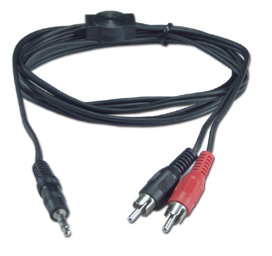

If you’ve been practicing for a while, or want to go hardcore, then bring your headphones and an external soundcard. But you don’t really need those for your first gig.
How do you prepare?
What should you play?
That’s really up to you. I don’t think you can call yourself a swing DJ if you have less than 90% of your (DJing) collection devoted to swinging jazz. I have lots of other music, but I don’t DJ it for swing dancers. If you’re totally stuck for ideas, perhaps you should work on your music collection for a while before you start DJing.
Don’t expect to be the best DJ in the world your first time. Just go and treat this as a learning experience that could be fun. Just like dancing, the more social dancing you do, the better you’ll get, the more you’ll learn.
[EDIT: This is one of a number of loosely-associated posts about music in Sydney lindy hop today. This list includes:
]
This post is the second of two. In the first part (NEEDS MOAR DJS ? (part 1)) I rambled on about Sydney’s DJing culture at the moment, particularly in reference to its social dancing culture and basic demographics. This second part spends a bit of time talking about why DJing sucks and why I like DJing. At some point in the future I’ll try to write about how we might (despite all our better instincts) go about encouraging new DJs in the swing dance scene.
I’m going to carry on with the (increasingly ridiculous) point that we need more DJs here in Sydney. Because as things are going, we’re in pretty dire straits: NEED MOAR DJS!!1!!
How do we get these moar DJs?
One of the most frustrating suggestions I’ve heard lately is that we should “just put out an ad for more DJs”. Gee, why hadn’t I thought of that. As though there are squads of skilled DJs sitting about at home who hadn’t thought about DJing. Or rather, the implication is that any old fool with some music can DJ.
*headdesk* repeatedly
Here is where things get tricky. Yes, any old fool with an ipod or a laptop can just plug into a sound system and play some music. But this is what will happen 99% of the time:
The best case scenario in these moments is that the dancers will be ok with one of these DJs pulling this rubbish, so long as there’s a second DJ who’ll play ‘real’ swing music. Either way, you’re going to need a second DJ or some sort of technology-savvy person working with the new ‘DJs’ to help them actually make sound come out of the metal box.
And of course, we haven’t even begun to approach a DJ who has a) decent music, and b) knows how to combine it, and c) work the room so that people have a chance to breathe/get their groove on.
Who’d have thought. DJing actually requires some skills and knowledge.
So, yeah, just putting out an ad won’t turn up any surprise DJ gems. It might get you one or two people who have an interest. But what you’ll probably get is a bunch of guys with inflated egos who think DJing is ‘easy’. You might get one or two women, but they won’t have as much confidence as the guys. What will probably happen is that the few people who are actually interested in DJing swing music for swing dancers will pay attention to how things turn out, and then they’ll be disappointed and put off by the reality and the fallout of that reality.
As with building a swing dance scene generally, new DJs are more the result of long term plans and strategies than surprise discoveries.
This ‘just put in an ad for DJs’ approach is a clear indication of the value of social dancing and of music – low. This makes sense if your financial bread and butter is classes, and social dancing an optional extra. It’s also the antithesis of how I approach dancing. I see classes as a place for me to develop skills which make my social dancing better/easier/more fun/more creative. If your business relies on class attendance (rather than social dance attendance), it’s important to develop an institutional discourse which values pedagogy – learning and teaching – above all else, and which also articulates clear hierarchies of knowledge. Most importantly, learning is positioned as something which happens in classes, knowledge is bought and paid for, then passed from teachers to students like a little package.
What this really makes clear, I guess, is the way Sydney (and Melbourne, at least until about 2008) relies on dance schools to put on social dancing events. I don’t know if this happens in other scenes. But dance classes are the centre of the community, rather than the ground crew or entry point for a vibrant social dancing scene. I’m not sure why. Maybe we just seem to assume that running classes makes better business sense than running regular social dances? I mean, we only have three annual events, nationally (of a total of twelve or thirteen), which are all social dancing, with no workshops: Canberrang (Canberra), Devil City Swing (Tasmania) and MLX. MLX is the best-attended, largest of those events, and began as a workshop weekend. I often wonder if our national obsession with workshops has something to do with Australia’s small and geographically dispersed population. Or if it’s a result of our distance from the rest of the lindy hopping world. Historically, traveling to dance in Australia has been centred on workshops and learning rather than social dancing.
…but look, I’ve wandered off-topic again. It is relevant, because it explains why I think music and social dancing are so important to a contemporary lindy hop culture. It’s not just because I love social dancing above all else, or because I am a DJ, with much to gain from a community valuing my skills. I do think that a modern lindy hop scene cannot be truly socially and creatively sustainable if it does not include social dancing. Because social dancing is really challenging. And it’s also the place where dancing stops being a series of monologues and becomes an exciting, challenging discourse. It’s called social dancing for a reason. But let’s get back to talking about DJing.
There are other ways of encouraging new DJs.
I’ve written quite a few posts about getting into DJing:
Looking at that list, all I can think is:
NONE OF THIS IS ENCOURAGING. These are not helpful posts. tl;dr Too depressing. Too much thinking!
I need to write a post talking about how to encourage people to take up DJing. I really do. But this is not that post.
Basically, becoming a good DJ requires a lot of time. Yeah, some money. But the time is the biggest investment. Time to learn music. To learn how to use technology. To spend actually DJing and moving from sucking to being half decent and then, finally, good. You can be competent within a year, but it takes at least a couple of years to get good. Just like lindy hop, DJing for lindy hop is a long term project. Time spent sitting on your arse DJing instead of dancing. That always surprises new DJs: you don’t get to dance to the music you love that you’re playing? No, buddy, you don’t. Because there are very few people who have the ninja skills to pull off a good set while dancing to it. And 90% of the guys (and they are blokes) who dance while DJing aren’t anywhere near as good as they think they are. No, buddy, you’re not.
And if you’re just in the scene to have fun and dance, why on earth would you waste your time learning to DJing, and then actually DJing? Particularly when there’s an awesome band on every free night you have during the week?
So you get these people to start DJing. Why would they bother to stick with it? The hours are shitty. You aren’t treated with a whole heap of respect – there’s no line of groupies waiting for you after a set. There’s next to no money in it. Unless that money is the money you sink into your gear and music. You’re far more likely to get abused by some blockhead venue owner or manager than thanked. You’ll constantly deal with idiots suggesting amazing songs no one ever plays. By Wham. Most of the sets you do will be small time local sets for mixed range of dancers who’d really rather talk and flirt than dance. Unless you’re in a big scene with a core set of hardcore dancers. That means Melbourne, in Australia – we just don’t have that significant core group anywhere else, not in decent numbers. Even in Melbourne, though, most of your sets would be for smaller crowds. Because the smaller sets are the bread and butter of a swing dance scene.
Golly, with all that bad news, why does anyone DJ at all? Why do I DJ?
So, really, there are lots of reasons to take up DJing. But how do you articulate all those things in the two minutes you have to talk to a dancer who may be interested in taking up DJing? Should you? It’s all very hippy and amorphous. And a little sweary.
I will try to write another post about how to get people interested in taking up DJing.
NB: There’s a nice, simple post about working conditions for DJs over at Words Pursued called Gotta Be Satisfied. This link came to me via a few people – Ryan Swift and (caution – FB link) Wandering and Pondering (also found at Wandering and Pondering.)
There’s the beginning of a discussion about related issues over at Swing DJs in the DJ Administration thread I started, but I don’t see that going anywhere.
As with most politically sensitive issues, most of the interesting talk will no doubt happen under the radar – on twitter, in emails, in private messages and face to face chats. I know I’m involved in about half a dozen conversations with people about these same issues. I tell you what, I’ve never been as aware of the role of unions as I am while talking about DJs. I’d never say it out loud (oops), but you can see how unionising – getting together as an organised group – is really in the interests of workers and bosses. The workers get more equitable working conditions and pay, the bosses get more consistent and reliable work from their employees. But shoosh. We won’t have any of that goddamn commie bastard talk here.
[EDIT: This is one of a number of loosely-associated posts about music in Sydney lindy hop today. This list includes:
]
In this post I ramble on about Sydney’s DJing culture at the moment, particularly in reference to its social dancing culture and basic demographics. It began as a huge post, but has split into two. The second one (NEEDS MOAR DJS ? (part 2)) spends a bit of time talking about why DJing sucks and why I like DJing. At some point in the future I’ll try to write about how we might (despite all our better instincts) go about encouraging new DJs in the swing dance scene. I’ll begin this discussion with a blanket statement: Sydney’s swing dancers like live music. I’ve written quite a bit about it in this post ‘Swing Dancing’ and Lindy Hop in Sydney: an Exercise in Speculative Fiction. But we also quite like DJed social dancing nights as well.
I think there’s a link between a scene’s age and its use of DJs. New scenes rely on bands for social dancing, and only use DJs to fill in after class or in informal contexts. Yes? Hm. That seems a long bow to draw. But let’s leave it for now, and move on to another spurious declaration. Older scenes develop fairly complicated and professionalised DJing cultures and DJs. They also produce better DJs, usually people who’ve been dancing for a while, but not always. In recent moments, though, some of the older scenes in America have returned to live music in a big way (Seattle), and scenes in cities like New York and New Orleans are seeing increasing attention to their live music cultures from local and visiting dancers. In these scenes DJing has taken a more supportive (though still essential) role. Sydney dancers traveling overseas to scenes like these are bringing this idea back to our city: live music is good. Their online discussion and interaction with dancers from those overseas scenes reinforces the radical ideas traveling dancers bring home to Sydney. The idea that ‘live music is good’ (and ‘cool’) is also circulating in other Australian scenes, and reinforced when Australian dancers meet up at events or talk online.
For an awful lot of dancers, the idea of what they should like (as propagated by teachers, influential individuals (teachers, etc), the programs of high profile events, etc) is more important than what they might actually like. For example, most people find themselves, mid-dance liking dancing to LCJO’s ‘C Jam Blues’. But most dancers who’ve been around for a while don’t like the idea of dancing to it. Because it’s too overplayed/slow/bigband/whatevs. This fascinates the part of my brain that likes to think about taste and cultures of taste and the influence of various digital media. It can really frustrate the other part of my brain that likes to DJ stuff I like, which doesn’t always coincide with popular trends (enough goddamn tuba-shouting-banjo for Ceiling Cat’s sake! For pity’s sake, give me a little classic big band swing for my lindy hop!) But, for the most part, it’s difficult to argue with this fad. Live music: it is good. It really is.
So there’s something of a tension between DJed and live music social dancing in Sydney. They often attract different crowds and are managed by different ideological, financial and political forces.
Let’s talk numbers.
Sydney lindy hop demographics. There are about 4.5 million people living in Sydney (and about 4 million in Melbourne). Sydney is the largest city in Australia, though not the fastest growing. DJing isn’t one of the largest pools of labour in the Sydney lindy hop community – there are only about thirteen of us. There are about fourteen teachers working regularly and occasionally with the two larger inner city schools, and many teachers are also DJs. There are a bunch of other teachers with the other schools in the outer suburbs, but I don’t know them at all really (I’d put them, conservatively, at about ten teachers). Unpaid volunteers number anywhere between fifty and one hundred across the two larger schools (this is a difficult one to quantify). I have no idea how many people take swing dance classes in Sydney. Sydney has hosted two or three larger annual events in the past (dropping to one this year) and a number of smaller workshop weekends. There is a great deal of cross-pollination with the Canberra scene, which is only a three hour drive away. No other Australian scenes are so close together – most are at least eight hours drive apart (I am blurring Geelong into the outer suburbs of Melbourne).
Sydney has lots of social dancing. Because we have lots of DJed social nights. We have three regular dancer-run DJed events: Swingpit, Roxbury, Jump Jive n Wail. JJW is mostly rock n roll, jump blues and neo swing, and it’s a gig managed by one professional DJing couple. It’s a majorly popular cross-over point between the rock n roll, rockabilly,’swing’ and lindy hop scenes. Roxbury and Swingpit are run by two different dance schoosl and are on fortnightly, on alternating weekends. Swingpit uses four DJs per month, Roxbury between four and six per month. They tend to draw on different DJing pools. Then there’s the new and irregular North Sydney after-class social dancing, which has one or two sets per month, give or take. DJs are also used for other occasional social dances – the (irregular) late night Speakeasy, band breaks for live music gigs run by dancers, and larger social dances run every now and then.

(Me, Ben and Kat, DJs for the SP performance ball this year. Not the most thrilling DJing gig; we may have been distracted by our own fun.)
Sydney’s complicated cultural architecture leaves us in a fairly tricky position when it comes to running DJed social dancing nights. Basically, we don’t have enough DJs to fill all our DJed social dancing spots. Our current venues use between ten and twelve DJ sets per month. That’s at least two sets per week. Of the ~thirteen DJs in our town, five DJ regularly and have solid skills. Only three of those DJ interstate, and only two or three would I hire for a big interstate event. We also have five DJs who DJ irregularly, but who would really rather dance. Two of the thirteen very rarely DJ any more (and haven’t in literally years). We have one or two or perhaps three or four who are really green. And then there are assorted blues DJs who don’t get to DJ anywhere any more at the moment, as our blues scene has pretty much collapsed.
When you look at the number of sets to be filled, those thirteen DJs don’t go too far. Some (like me) will do quite a few sets, but cap at about three per month. Most would rather DJ no more than once a month. Some are on complete hiatus.
At this point I simply can’t get enough DJs to fill the slots at Swingpit alone. This is partly because it’s November, and November is a busy month. Sure, people go nuts in December with parties and stuff, but in November people are really working their guts out at work. And Sydney can be an expensive town, requiring jobs that can be quite demanding. We’re also at the tail end of exchange season in Australia – there are about six large events in October and November, plus a round of christmas dances and festivals. So most of the DJs (and teachers and dancers) are kind of tired and burnt out. They just can’t manage DJing on top of everything else.
So we have lots of healthy social dancing nights, quite a lot of keen social dancers, but not enough DJs to do the DJed gigs. The obvious solution would be to put on bands instead of DJs. Bands pull numbers, and Sydney is busy proving there’s a clear market for live music events catering to dancers. So why don’t we just swap bands for DJs?
There are some financial issues at work. Neither Swingpit nor Roxbury could afford to put on a live band every fortnight. Both events are run on quite a tight budget, in part because they only charge $6 and $5 respectively for social dancing entry. That’s nothing. It’s hard to find a decent lunch for $5 these days, let alone a good night of fun dancing. An obvious solution would be to charge more for the social dancing nights, and to put on a band with the extra money. Two years ago I think you’d have had an outraged chorus of tightarsedness from dancers. But these days we pay anywhere from $10 to $40 for live music at venues with good dance floors.
Despite these brilliant(ly unthought out) arguments, there are a range of factors affecting the finances of these events which need to be taken into account. And even I know not to discuss these sorts of things in detail in public. :D
A shift to live music at our regular, dancer-run core social dancing events would mean a larger shift in the way social dancing events are run. Coordinating a band involves different skills and contacts than coordinating DJs. Bands need proper pay, and DJs are largely regarded as ‘hobbyists’ or volunteer labour. DJs are usually dancers and (preferably) know how dancers use music. Bands know music, but aren’t (in Sydney anyway) serious dancers, so they don’t know how dancers use music. More importantly, one gig for dancers a fortnight is not the most important thing in a band’s working life. They have other, more lucrative (corporate) gigs in their schedule. I think, however, the biggest and most difficult challenge in shifting from DJs to bands would involve prioritising music and social dancing, which organisations who make their money from teaching are not willing to do.
What if we did drop DJs completely and use bands instead? I’m not sure how things would go. I don’t think class-centred institutions like dance ‘schools’ could accommodate such hardcore ideological shifts. That’s a whole different way of thinking about dance and about profitable dance projects. An entire reshuffling of the social hierarchies and (commodified) knowledge values of a community. I think the modern Sydney lindy hop scene needs DJs, if only because it means that it doesn’t then need to reassess the value it gives music, and the knowledge and financial economy of the scene as a whole. Such a major change would involve a lot of ground-level effort, which Sydney isn’t really built for. Not at the moment. But even with an increased emphasis on live music for dancer-run events, there’d still be a place for DJed social dancing, if only on a smaller scale.
Let’s pause for a moment, and think about me.

What would I like? In a perfect world there’d be social dancing every week. Twice a week. At least. By social dancing, I mean spaces and events that are perfect for dancing. A decent floor that’s not covered in drunks and broken glass. They could be with live bands. That’d be cool. But I’d be ok with a really good DJed event as as well. So long as they were really good DJs. To be honest, in my perfect world, we’d have a DJed dance once a month that featured only really top notch DJing, was held in a dance-centred space (like a not-too-big dance studio) with an excellent, appropriate sound system, with a bar next door or attached or something so we could get drinks or noms. But the dancing would be the most important activity. And by good DJing, I mean mad crowd working skills and excellent solid swinging jazz. No neo. No rock n roll. No fucking novelty songs. Just 1920s-1950s classic swing and modern recreationist bands. Combined cleverely by a DJ who’s watching the floor. Four hours of that once a month, and I’d be happy. I’d complement that with lots of dancing to live bands each week. Unity Hall on Sundays. A Friday night band in a fun venue like the Camelot Lounge. Saturdays at different one-off events with different bands. A different band (or two) each week.
I’d be quite happy retiring some of our DJed social dancing sets. My DJ skills would slide a bit, but I do DJ interstate quite a bit, so I’m not really all that sad about it. And, by gum, I’d much prefer dancing to DJing myself! Right, now I’ve almost convinced myself that crying “DJ drought” is really my missing the point. Perhaps it might be more useful to rethink a (short sighted, isolationist) DJ-centred approach to social swing dancing culture. It seems a better idea to integrate live music more thoroughly into our everyday dance activities, to reduce our DJed dancer-run events and present entirely new types of dancer-run DJed events.
So, really, is it so sad to lose DJed social dancing? Hmmmm…..
I’m going to continue this discussion in another post, as this one is way too big already. The second part (NEEDS MOAR DJS ? (part 2)) will talk about the frustrating parts of DJing and this ‘DJ drought’.
[EDIT: This is one of a number of loosely-associated posts about music in Sydney lindy hop today. This list includes:
]
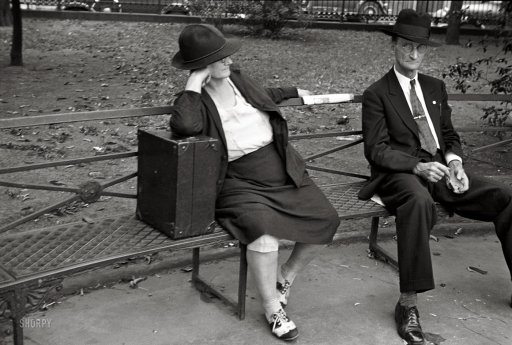
I’ve just done a new 8tracks:
These are just ten slower songs with women singers. Singers who have voices that make me stop and pay attention, or versions of songs that I’m just not sure about. These are probably, then, songs warranting a little suspicion. A second look, at least. Or narrowed eyes.
I put them together randomly, beginning with the Madeline Peyroux song. I saw her live a few years ago in Melbourne at a fancy theatre and she was a) really late on stage, and b) complete and utter rubbish. She really irritates me, and she fuddles her way through this really great song. That is why she’s here. Because, despite all that, the song is good because the rest of the band makes up for her mess. I’ve never played any of her stuff for dancers. Shame on me if I ever do.
Nellie Lutcher is a gun. She plays the piano.
Same with Martha Davis. This song is buttery, velvety magic.
Peggy Lee. Nuff said.
Same with Dinah Washington.
Ella Johnson: I keep forgetting her, and I shouldn’t.
Mildred Anderson, falls off the note every now and then, but her voice is amazing.
Koko Taylor will kick your arse up and down the stairs.
Molly Johnson, doing an unusual version of Summertime. I’m not sure if I like it.
(title artist album bpm year length)
Weary Blues Madeline Peyroux with Dean Parks, Larry Goldings, David Piltch, Jay Bellerose, Lee Thornburg, Scott Amendola Careless Love 92 3:41
That’ll Just About Knock Me Out Nellie Lutcher Hurry On Down 113 2:31
Kitchen Blues Martha Davis acc. by unknown BluesWomen: Girls Play And Sing The Blues 80 1947 3:05
Careless Peggy Lee and The Four Of A Kind Complete Peggy Lee and June Christy Capitol Transcription Sessions (Disc 4) 81 1947 2:06
Stormy Weather Buddy Johnson and his Orchestra with Ella Johnson Walk ‘Em 72 1951 3:19
Hey, Good Looking The Ravens and Dinah Washington Dinah Washington:the Queen Sings – Disc 4 – Please Send Me Someone To Love 132 1951 2:43
Hard Times Mildred Anderson No More In Life 67 1960 4:15
I’m Lost Mildred Anderson No More In Life 55 1960 4:36
I’m Gonna Get Lucky Koko Taylor South Side Lady (Live in Netherlands 1973) (Blues Reference) 58 1973 5:25
Summertime Molly Johnson Another Day 137 2002 4:23
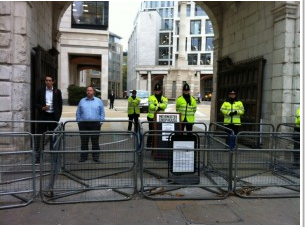
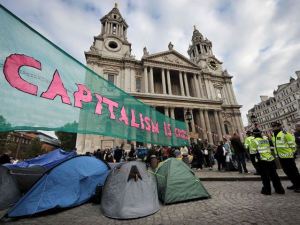
(tent image from here, police image from here)
I’m really interested in the discussion of official versus community policing of public space in Chris Brown’s article ‘The Occupy Movement and the Battle for Public Space’. One point I took from this was Brown’s juxtaposition of the formal, highly ordered occupation of public space by the police and ‘official’ entities with the informal, collaborative and negotiated management of public space by community groups. I think that both types of management of public space happen in all sorts of communities, and that they’re really just two points on a broad spectrum of behaviours. I want to spend the rest of this post taking this idea and applying it to dance competitions. Competitions which can be at once ‘officially’ managed public spaces and also collaborative or informally managed public spaces. At the same time!
I’ve always been interested in the way dancers regulate the social dance floor (which I’ve always thought of as ‘public space’ or public discourse). One of my favourite topics is derision dance. Or using dance to deride someone (using the dictionary definition “contemptuous ridicule or mockery”). This can be as simple as directing a crude gesture to your opponent, but it is often more complex, involving layers of imitation, impersonation and subtler mockery. This last type is what really fascinates me. I wrote about derision dance and layers of meaning in what again?! I’m still crapping on about dance, power, etc; I used derision as a tool for understanding blackface in blackfaces and performing identity. again. (again using the idea of layers); and I talked about cake walk as an example of derision in hot and cool.
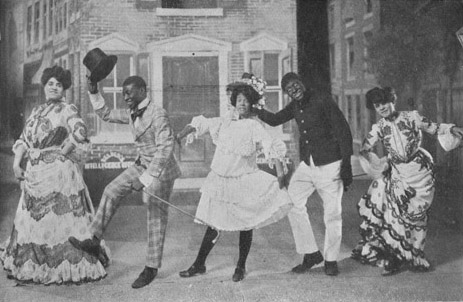
I keep coming back to the idea of dance as a forum or tool for deriding or subverting authority or an opponent because it’s a contribution to public discourse which doesn’t use words. I get a bit frustrated with work on public discourse which prioritises the written word, as there are all sorts of dodgyarse power dynamics happening there. Not all of us have literacy and linguistic competency on our side; class and race and ethnicity are pretty important factors here.
Of course, I’m not alone in talking about bodies in public space. That’s why I like that Chris Brown article. It describes the way non-verbal occupation of public space is regulated by official and community powers. When I think about dancers regulating the public space of the dance floor, I think about official ‘laws’ or guidelines like a sign forbidding aerials in a particular room for safety or heritage-building reasons. Or a more experienced or authoritative dancer telling an idiot lead to stop tossing follows into the air. But I’m also quite interested in the unspoken, unofficial and less overt management of public space in dance communities. It’s a little too far along the spectrum to ‘official’ to really illustrate my thoughts, but I want to begin with (and probably end with – as I’m off to the beach in a tick) dance competitions.
I’ve just been watching this clip from the studio we use of ‘The Crossover Popping Battle – Finals’:
There are all sorts of cool things to say about the way the studio uses Youtube and faceplant, where I found the clip, and which is so central to the studio’s promotional and community development work. But I’m not going to do that here. I want to start with the dancing itself.
… suddenly, I’m realising that this might be beyond me right this second. I want to do a close textual analysis of what is happening on the dance floor. There’s lots to be said about the mise en scene of the film itself as well. I think this type of close analysis of the dance-as-public-text requires a certain about of specialised knowledge. If you can’t read bodies as a dancer, you can’t really understand the power plays. More specifically, if you can’t read popping, you can’t really understand who’s the more proficient dancer, the intertextual and historic references in each movement, the etiquette for this sort of battle type competition. To add a few extra layers of meaning, this is a battle hosted by one particular dance studio, so you’ll see institution-specific action and ideology at work here. Not to mention the fact that these kids are from all across Asia, speaking a number of different languages as well as English. I’m a white Anglo-celtic girl living in Sydney and I only speak English. I’m going to miss most of the more nuanced physical gestures and postural moments. So my analysis is really only a beginning place, and I couldn’t possibly see all the detail at work here, least of all because I’m not into popping.
This is a pretty important point. I can’t see all the regulation and management of this public place – this moment of discourse – at work here. So I’d be bound to make mistakes. But because I am a babby, I’d probably be excused quite a few mistakes. So long as my participation improved. These guys are really friendly and welcoming, and I know I’d be cut a fair bit of slack. But eventually, even the most tolerant teachers and peers lose patience with social ineptitude and rudeness in a public forum.
Interestingly, the dancers at this studio encourage new dancers to enter battles almost from the very beginning. I’ve sat in on a casual battle, and a lot of leeway is granted for new dancers. In contrast, there’s a real sense in Australian lindy hop that only the ‘best’ dancers enter competitions, unless the competitions are for ‘up and comers’ or ‘amateurs’. Of course, definitions of ‘best’ vary between cities, and don’t match up comparatively. And, really, the most successful dancers have a very strong sense of self worth and faith in their own abilities. They really believe they are – if not the best dancers – in with a shot at becoming the best. That’s just how competition works. If you don’t really believe you have a chance, you won’t work hard in preparation, you won’t devote time and effort to the project, and you won’t bring your A-game in the final moment.
So this means that we don’t see lindy hoppers developing performance and competition skills in a relaxed, welcoming and informal setting as very new dancers. I’ve noticed the dancers at Crossover develop a real sense of self-awareness and understanding of lines and visual presentation far earlier than most lindy hoppers. They work with mirrors right from the get-go. They spend a lot more time looking up and making eye contact (particularly in battles). In brief, ‘their movements go right to the end of their finger tips’, whereas a lot of lindy hoppers don’t even really know they have hands.
So, when you go to a battle with these guys, there’s rarely an explanation of the ‘rules’, beyond the very basics. This confused me when I first saw them in action. How was judging decided? How long did dancers have to perform? How did they decide who danced in what order? You’ll find rules for competitions on websites before the event, but mostly you just have to figure them out. And of course you won’t be in the competition if you haven’t at least acquired even that much cultural knowledge.
The same sort of thing happens with lindy hop competitions. Though most of the more popular recent comps have far more implied than stated rules. In fact, there was a conscious movement away from prescriptive rules in the US at some point in the early 2000s (I can’t really remember the details, sorry). Most Australian competitions followed this American trend largely as following a trend (rather than as a critical engagement with existing competition culture) a few years later. The exception is Hellzapoppin’, which was deliberately developed as a lindy hopper-run and regulated competition advertised as having ‘no rules’. Though of course it does have rules, and these are listed quite clearly.
These rules are just a little different to other more prescriptive events like the ASDC and rock n roll or ballroom competitions. The inaugural Western Sydney Swing Dance Competition had quite strict, ballroom/rock r roll type rules, but I found it really difficult to discover much about the competition beyond this flyer. I ended up messaging the organisers on faceplant to find out more, then had a fairly long list of rules emailed to me as a pdf (which you can have a look at here). I found these rules really difficult to understand, in part because I’ve done very little competition, but also because I’m not a part of the rock n roll or ballroom dance scenes, which are far more tightly structured and formally organised than the lindy hop scene. I simply don’t have the language tools or cultural knowledge to navigate this sort of text.
The Crossover competition, though, is far more familiar. Rules for larger battles are often discussed in an informal way on faceplant, but more usually discussed in person. But learning the rules of competitions is more a matter of enculturation. The competitive space is as highly regulated as the WSDC, it’s just that the regulation is managed in a different way.
I’ve spent quite a bit of time in the past analysing lindy hop competition footage in close detail (‘lindy hop followers bring themSELVES to the dance; lindy hop leaders value this’ is probably the best example of how I approach this). It’s a very common practice for most lindy hoppers, and learning how to read dance (whether in footage or in person) is an ongoing process. Dancers are also on the lookout for different things. Leaders and followers often read a dance clip in quite different ways. I look for gender stuff. Someone else might be looking at shoe types. A DJ might be listening for new songs.
I’m going to get completely off-track here with a reference to a very famous dance clip.
This is a still from the Big Apple scene from Keep Punchin, featuring the Whitey’s Lindy Hoppers:
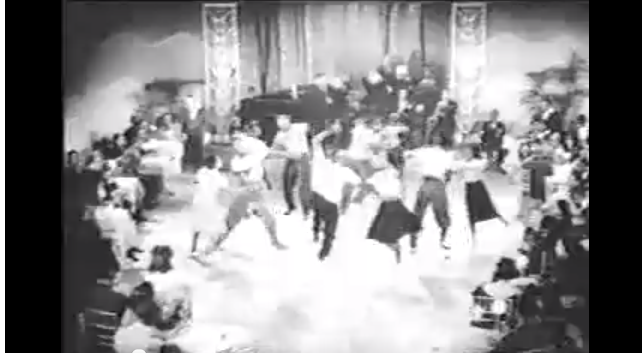
I’ve heard (second-hand, unfortunately), that Frankie Manning described this scene as a dance competition. In fact, the MC in the film introduces it as “The Big Apple contest”. Frankie explained that not only were couples competing against each other, but that individual partners were competing against each other. I’m not sure whether I’ve gotten that story right – it does come to be second-hand. But it’s an interesting idea. Competitors are working in pairs, focussing their performance on each other, as well as on those around them.
This is a bit like the Crossover battles (as far as I can tell – I’m not 100% sure about this next bit). In these battles competitors may enter as teams of two, but they dance alone, focussing their attentions on a particular member of the opposing team. There’s lots to say about focussed competition, and about how dancers in these battles turn their aggressive (yet never violent) competition on when they begin dancing, and then off when they move off the floor. I’m particularly fascinated by the way the non-dancing team member stands in a decidedly ‘I’m not dancing’ pose; they turn off their competitive dance energy, often by not making eye contact with their opponents. That’s some pretty basic non-threatening body language right there.
Right, back on-track, now…
It was quite interesting to see the new competition format for the Harlem 2011. Solo Jazz Contest held in Lithuania. It looks a lot more like the Crossover popping battle than other solo jazz comps in the lindy hop scene. How?
Firstly, here are some screenshots from those clips to illustrate my points:
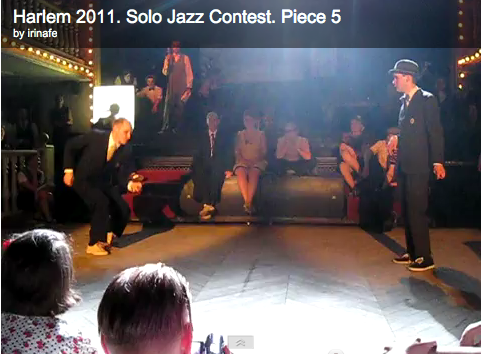
(Harlem 2011, one of the rounds)
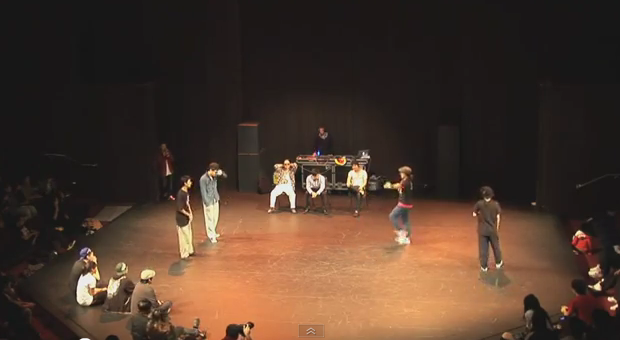
(Crossover popping battle, final)
There’s so much more to say about this. I’d like to go through and carefully analyse what’s going on in the Crossover clip, and to compare it with various lindy hop and solo clips. There are interesting things to say about the placement of DJs in the competitive space. Or how competitors in a pro or invited jack and jill comp sit in a line at the back of the competition space (they are often actually formally judging each other). This demands comparison with the way lindy hop couples line up in order along the back of the competition space waiting to enter the jam, and are far more actively engaged with the dancers currently on display. And of course, I want to talk about the way the competition space is delineated by these lines of competitors, by the audience, by lighting, by the dance floor itself.
All of these things relate to how the physical competition space is regulated and negotiated by the community, and also by official forces. The ultimate authority is the individual or organisation running the competition. Yet one of the greatest delights in watching street dance (or vernacular dance) competitions is waiting for the moments where rules and authority are deliberately contravened, or at least stretched. When judges request a rematch. When competitors physically touch each other (forbidden!) When competitors touch the audience (doubly forbidden!)
I’d also like to talk about how conversation is managed, both formally and informally. There’s lots of lovely stuff written about all-male and all-female conversation and how formal turn taking dominates all-male talk and interrupting and collaborative meaning making (eg women saying ‘oh no!’ and nodding or saying ‘yes’ regularly interrupt but do not disrupt the speaker) characterises informal all-women talk. I think of dance as discourse, and occasionally use this idea of dance as conversation to explore dance as discourse. It’s not a unique idea – dance teachers use this idea all the time. But while I might have begun thinking of dance partnership in particular as conversation with formal turn taking, I’m now a lot more interested in a model of high level partner dancing as more like collaborative, overlapping conversation. And of course, I extend this idea to include jazz music, with its sections of structured unison, its layers of individual, interrupting parts, and its moments of solo improvisation. I probably like New Orleans stuff because it favours layers of improvisation instead of carefully choreographed unison and demarcated solos.
But enough! I must swim!
This is a story about live music in Sydney, and how lindy hoppers and swing dancers use it and find it. I’m really going only on anecdotal evidence, backed up by my own supposition and thinking. I don’t have a lot of hardcore facts about the history of Sydney lindy hop to back me up. So I’ve tried to avoid talking about anything besides the 2008-2011 period, and to keep my comments about stuff I don’t know anything about to a minimum.
Sydney’s swing dancers like live music.
Perhaps the most important factor in attracting a dancing crowd to a live music gig is a sympathetic venue. This means venues actually letting dancers dance, and then understanding that they can cater to both dancing tight-arse dancers and drinking, non-dancing punters. The Unity Hall Hotel always hosts a group of dancers on Sunday. The Camelot Lounge hosts some of the best live jazz in Sydney (from interstate and local artists). Venue 505 has initiated its own dancer-centred gigs showcasing some astonishingly good Sydney musicians. The Sydney Festival always attracts a zillion dancers, particular events like the Trocadero Dance Palace and Spiegeltent. In contrast, while the Sydney Jazz Club hosts some of the finest jazz bands in the country (and from overseas), it uses venues with smaller dance floors, rubbish food and lame, ‘old people’ vibes. RSLs. Outdoor parks. Yacht club function rooms midday and mid-week.
Our live jazz music (music suitable for lindy hop or ball or blues or whatevs) scene is healthy: lots of good bands, made up of jazznick elder statesmen and young guns. The older jazznicks largely cater to a rapidly aging jazz fan base, neglecting a potentially lucrative market. This is a shame, as Sydney is home to some of the country’s finest (older) musicians. I can go on and on and on about the Ozcats. Or the Unity Hall Jazz band. But these musicians and bands have a weak online presence, relying on face to face promotion, flyer drops at events, local radio announcements and the powerful Sydney Jazz Club old school social network: word of mouth. Nanna power. Sydney lindy hoppers use a combination of online talk (mostly through faceplant) and face to face talk to decide which bands to go see and when.
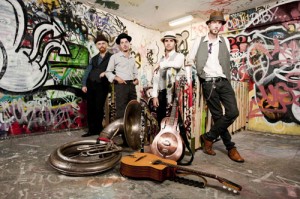
(The Cope Street Parade)
Younger jazz bands and musicians – many of whom have been associated with the Sydney Conservatorium of Music – are an interesting group. They’ve made good use of online tools. They have faceplant pages, myspace pages, a presence on sites like Reverb Nation, their own websites and occasionally twitter accounts. Faceplant is by far the most influential of these tools, but really only in concert with other media (a solid website or myspace page, soundclips or videos on faceplant itself). A group of these younger musicians are involved in a number of bands showcasing different types of early 20th century American folk music – from sacred singers (you can find the Surry Hills Sacred Harp Singers on faceplant) to bluegrass and hot jazz combos. They’re also launching a record label, Yum Yum Tree Records.
These musicians have strong relationships with younger lindy hoppers who travel or who are otherwise plugged into the modern lindy hopping world, via faceplant, youtube and other online social media. The Cope Street Parade has a core group of keen dancers following them to their (pretty much) weekly gigs. Cope Street’s popularity can no doubt be attributed to their musical style. They have much in common with popular American ‘street jazz’ bands like the Careless Lovers, Smoking Time Jazz Club, the massively popular Tuba Skinny and The Loose Marbles. This sort of music has been hugely popular with American and European lindy hoppers lately, and many of the younger Sydney dancers in particular are on board with this trend.

(image lifted from this site)
Pugsley Buzzard also has a keen fan base. His month long residency earlier in 2011 at The Mac in Surry Hills attracted dancers even with only a carpeted space for dancing. He’s also performed at the Sydney Lindy Exchange a few times, is booked in for the Sydney Swing Patrol christmas party next week, and has played for dancers at Canberrang this year. He is, sadly, relocating to Melbourne.
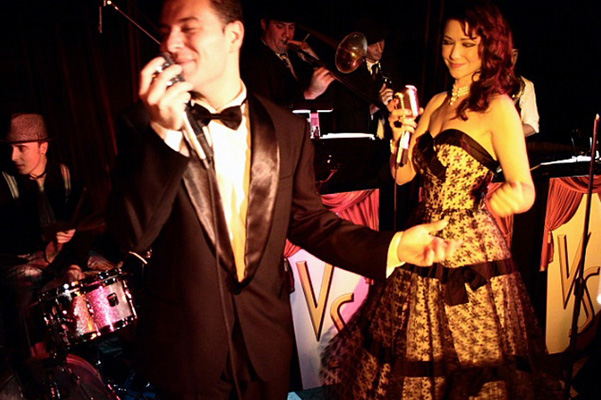
(The Velvet Set)
This brings me to the neo swing or ‘swing’ bands which cater to a slightly different audience. Bands like the The Velvet Set offer neo swing and crooner jazz rather than proper swing, but are very popular with ‘swing dancing’ crowd, some lindy hoppers and the rock n roll crowd. That’s what I want to talk about, but I think I need to talk a bit more about Sydney lindy hop and swing dancing demographics first.
I wonder if Sydney’s interest in live music is in part an indication of some of the troubles this scene has had over the last two four years. Sydney is an old scene – the oldest in Australia, founded in the mid 1990s or so. But its numbers and cultural complexity have fluctuated. Numbers had been down, with more experienced hardcore lindy hop dancers suffering some teaching fatigue and newer dancers not sticking around til they become hardcore. But our numbers have picked up in the last year. This means that Sydney is essentially a ‘newer’ scene and an older scene: a mix of very enthusiastic newer dancers and experienced dancers in a range of age groups.
It’s really not been until the last couple of years that we’ve seen Sydney dancers traveling to interstate events in significant numbers, though they have always travelled overseas, often in quite large numbers. There’s always been one or two or a handful at interstate events, but the last two years in particular have seen whole squads traveling to Melbourne, Perth, Adelaide, Canberra. All this travel within Australia has seen personal relationships developing between Sydney and interstate dancers. Relationships fostered by faceplant in a really important way: this is where people share videos and email addresses, encourage each other to visit again and finally get to talk to people they’ve only danced with. Interstate travel has also been important for making Sydney dancers aware of the limitations of their very small pond. They may be big fish at home, but they’re meeting and seeing and dancing with some much larger fish from much larger ponds. This sudden reality check can break a dancer’s confidence, but it can also spur a sudden interest in improving dancing skills. Competitions are, once again, a space where these sorts of realisations occur.
There are three (or four – I’m not sure exactly; the western suburbs are a mystery to me) major teaching entities in Sydney, and there isn’t a whole lot of interaction between all the schools. Two of these schools, catering for inner city and inner suburb areas – have plenty of students in common, which I think is a really good thing. If you provide diverse learning environments for students, you stimulate their interests and you create a market for mo social dancing and mo classes. Win! Only these two schools run DJed social dancing nights and have a real connection with other cities’ scenes and large events. The other schools are quite isolated, in terms of international lindy hopping culture, and I think this has had a detrimental effect on their dance skills and (dare I say it) musical taste.
But to get back to the whole neo swing thing, Sydney overall has a much stronger link with neo swing and rock n roll than Melbourne or other cities. There’s a hardcore lindy hopping/balboa crowd, but there’s an even larger group of dancers who are often older, began dancing in the 90s, or have much stronger links with rock n roll dancing and music. Many of the people guys often think of themselves as ‘swing dancers’ or ‘doing swing dance’, but I wouldn’t call them lindy hoppers. They may take the odd ‘swing dance’ class from lindy hoppers, but their first love is rock n roll (or rockabilly)
The younger ones are a lot more interested in looking good than the average lindy hopper. Many of them have stronger links with the goth or hardcore vintage fashion scene than with a dance scene. Dancing might be part of their social lives, but only part. Lindy hop tends to absorb your whole life, to become your lifestyle. This ‘swing’/rock n roll crowd have hardcore retro/vintage outfits, ride or drive vintage motorbikes or cars, and bring much more money to the bar. I suspect that their interest in looking good impedes their dancing ability. Rock n roll is easier than lindy hop, and guys can stand around looking good while they manhandle their (ALWAYS female) partners through endless spins. I am being quite harsh here, but while they look very good, this scene is not really all that when it comes to mad dance skills. Although, if you’re looking for a hot partner for a quick shag, this is a much better place to look than your average lindy hop scene.
The best attended live music events are in that neo swing/rock n roll vein.
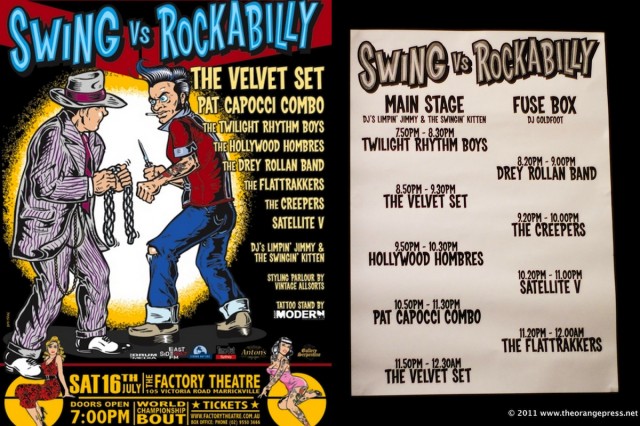
This Swing V Rockabilly poster is a good example of the sorts of things I’m trying to explain. The ‘swing’ guy in this poster (on the left) is what I associate with late 90s lindy hop – zoot suits, black and white shoes, wallet chains, hats. Very Hey-Pachuco! It kind of makes me cringe, because I associate it with the scene when I started dancing in Brisbane, and which I tend to associate with the neo swing scene, which was much more closely linked to ska and punk than jazz. Sure, it’s lots of fun – it was lots of fun – but the dancing was a bit rubbish, and it’s a bit dated. Lindy hoppers kind of got game these days.
Hardcore badass top shelf lindy hoppers look a bit more like this:
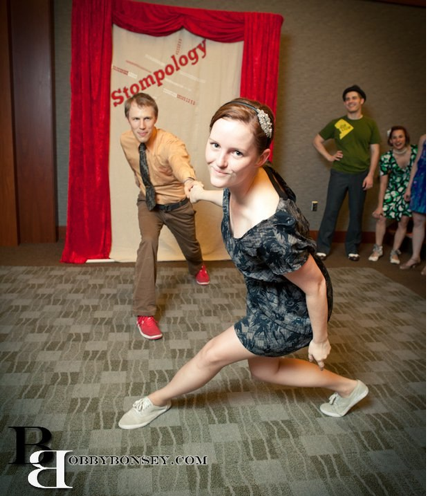
This is a photo by Bobby Bonsey, which I found here. He’s taken some really lovely photos of dancers. He’s also a badarse dancer. I particularly like this one of Chance and Giselle competing. I think that Bobby’s photos really capture the feel of American lindy hop today, which is much more athletic and physically exciting than 1990s Australian lindy hop. Lindy hoppers today look a lot more like the Whitey’s lindy hoppers – sinewy, fit, athletic. Like long distance runners or gymnasts. They wear form-fitting clothes that won’t impede their speed. They’re a long way from the zoot suits and silly cheap black and white shoes of the 1990s. And the ‘swing dance’ scene of Sydney today.
When I look at that ‘swing v rockabilly’ poster, I wouldn’t count any of those bands as ‘good lindy hopping bands’. They’re really rock and roll bands, but with mo brass. Most of them are quite good bands – lots of fun, lots of energy, good live shows. But not as musically accomplished as bands like Glenn Crytzer’s Blue Rhythm band. Crytzer’s band combines the exciting, rough-edged ‘authenticity’ of street jazz (and Meschiya Lake contributes in a big way to that feel in this clip) with solidly ‘authentic’ hot jazz instrumentation, arrangements and feeling. Here, let me show you what I mean:
This band feels like a real progresion – musically, technically, stylistically – from what’s been popular with dancers lately. Old school music and dancing. Street jazz ‘honesty’ and emotion. Exciting, committed musicians really connecting with dancers. Crytzer’s been engaged with the lindy hop scene in a big way (I’ve written about this before in Bands For Dancing), and his band is really top notch, swinging hot jazz. Also: uber exciting fun.
In contrast the Velvet Set are trotting out almost exactly the same set lists as swing DJs were playing twenty years ago. Crooners. Covers of ages-old neo swing songs. I don’t particularly like neo swing for lindy hop (because it doesn’t swing, and because it’s a bit naff), but I respect neo swing bands writing their own songs, improving their skills and really bringing their best to music they love. Here, check it out:
I don’t mean to badmouth the Velvet Set. They really are filling a niche in the market – there are plenty of dancers in Sydney who really like this stuff. They like the crooners, the covers of neo songs. Either because they were there in the 90s when this was the swing scene (this 2001 clip kind of gives you an idea of that scene), or because it moves them now. I think neo swing is accessible for many dancers – especially those from the rock n roll scene and new to lindy hop – because it’s a lot more like modern rock music and a lot less like proper swinging jazz. Swinging rhythms and hot jazz can be quite alien for new dancers, and neo swing has a clear, unswinging beat that sounds a lot safer. And people really like that pin-striped, zoot suit look.

(img lifted from this 1944 newsreel)
This is quite interesting, because 1930s and 40s Australia really didn’t have the sort of ‘pure’ lindy hop culture that the US did. The sort of dancing these modern ‘swing dancers’ do, with its emphasis on 6-count steps like pass-bys, under-arm turns and so on (rather than the swingouts and more varied, complex counts and rhythms of lindy hop) actually look a lot more like the ‘swing dancers’ of the 1940s in this 1944 newsreel (thanks to Bobby White for reminding me of this).
This means that we nerds harping on about lindy hop – Harlem or LA – style, are actually less historically accurate (for our geography) than the ‘swing dancers’ at the Swing v Rockabilly gig. But then, a bunch of modern day middle class Sydney kids pretending to be working class black New York kids from the 30s is kind of dodgy, historically (and ideologically) speaking anyway.
To sum all that up, we’re looking at two different ‘swing dancing’ cultures in Sydney, the lindy hop one and the one more closely associated with rock n roll and neo swing. There’s lots of cross-pollination (usually lindy hoppers visiting ‘swing dance’ events), but they are distinct musical and dancing styles, and overall equate to a large Sydney dance scene which has always had strong links to the live music scene. It’s just that only one really gets into 1930s and 40s swinging jazz music. And that other likes it with a backbeat and a well-stocked bar. All this means that Sydney has a labouring DJing culture, a scene obsessed with live music, and lots and lots of social dancing nights – run by dancers and by local venues putting on bands.
Sydney’s interest in live music also means that we’ll turn out in force for visiting musicians from interstate or overseas. And by force, I mean a few hundred dancers – both hardcore lindy hoppers and ‘swing dancers’ of the more rock and roll variety. Sydney is a great town for live music, and that has bled into the dancing community, something that didn’t really happen in Melbourne, for instance, until very recently.
I might not be a fan of neo swing, but I do realise that having a vibrant partner dancing scene is a very good thing for lindy hop. And an interest in live music is good for musicians, and good for dancing.
[Edit: if you’re still struggling with the zoot suit thing, I wrote a post called zoot suit riot (riot) about it.]
[EDIT: This is one of a number of loosely-associated posts about music in Sydney lindy hop today. This list includes:
]
I’m doing some DJing at the upcoming MLX11 in Melbourne, and one of my sets is a blues/lindy crossover type set. In an ‘old school’ blues room. Usually these sets are a pain in the arse, but because I’m head DJ (aka BOSS OF ALL MLX DJS… i wish), I gave myself this brief:
Play slower swinging jazz and blues music. Sell it as ‘R Rated’ because that’s the sort of music you play anyway.
And I seem pretty cool with that task. So I’ve started putting together some stuff, the usual suspects. My goal is to play upenergy stuff rather than slow, quieter, mellow stuff. Again, as per usual. It’s going to be lots of fun. But I need to do some serious preparation as I’m a bit out of practice. Or rather, I don’t feel all that confident.
Alberta Hunter is kind of overdone these days, but this video reminded me of her excellence. I also think it’s kind of exciting to see an older woman up on stage talking way dirty and funny. The way she looks is really important.
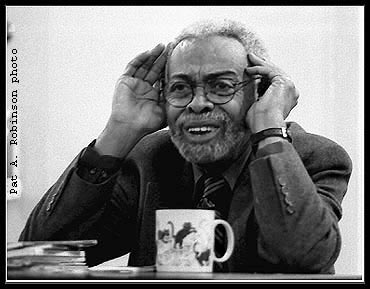
(Photo of Amiri Baraka by Pat A. Robinson, stoled from here).
Long time no post. I’ve been busy with a few different projects lately, most of them impeded by vast quantities of randomly-generated anxiety. I’m bossing some DJs for MLX11, I’m bossing some DJs locally, I’m sorting some solo dance practices, I’m looking at venues, I went to Church City Blues, I’m doing lots and lots of exercises to help my knees, I’m trying to improve my own DJing, and I’m working on at least two websites. They’re actually all the fun things. Also, we’ve started cooking meat at our house. The less said about that the better.
Perhaps the most challenging part of all this is trying to get my brain in gear for writing coherent sentences. More than one at a time. Ones that link up and make paragraphs. Anything more than that is really a little too ambitious right now. Writing. Why are you so demanding? The hardest thing in the world is writing properly when your brain won’t stop buzzing and fretting. Dance workshops? Actually quite good when you can’t make your brain shush. Forty minutes of slow, careful strengthening and stretching exercises every day? Quite calming, actually. But anything creative or requiring sustained creative thought – choreography, writing, editing… that shit is impossible. So here is something messy. Because it’s like learning to dance fast. If you never actually do it, you’ll never be any good at it.
Right now I’m thinking about writing about music. Again. I think it’s because I like to write about music. I’m also a woman. Wait – that last part is important (have vag will type). And because the things people write and say about music shape the way dancers and DJs think about music. And that affects the way they dance to music, which bands and DJs they hire to play their events, whether and how much they pay musicians and DJs, and what sort of music they put into the event programs. I know this is kind of old school literary studies/cultural studies/media studies stuff. And I even wrote about it in my PhD.
But now, I want to write and think about it again. Because I am organising DJs for MLX, and because I’ve noticed a clear trickle down (or bleed out?) affect from the developing online dancer discourse to the face-to-face. Yes. My PhD has come to life. Basically, Faceplant, blogs, podcast, youtube and all those other goodies are having a clear effect on face-to-face dance practice. Dancers are writing more about music (and dance), Faceplant has increased the penetration of this writing, and dancers are now reading more about music and dance. And this is having clear effects on how dance events are run. And on the interpersonal and institutional relationships and power dynamics of the international lindy hop scene. Yes, I will make that call. I can’t help it. I’m trained to see words as articulating power and ideology. And discourse as at once articulating ideology and creating it. I CAN’T HELP IT. I HAVE LEARNT TO USE MY BRAIN. ALL THIS THINKING WILL NO DOUBT RESULT IN THE COLLAPSE OF CIVILISATION AND RISE OF OUR FELINE OVERLORDS (WORSHIP THEM).
So what I’m saying, here, is that I’m getting that niggly tingly itchy feeling in the back of my brain that tells me there’s something going on that I need to pay attention to. Some dots are being joined. Unfortunately not by my conscious, rational brain, so you’re going to have to muddle through some fairly irritatingly vague, malformed or downright wrongtown blog posts til I get it together. If this was a magazine or an academic journal you’d be reading coherent sentences. But it’s not. So you’re getting dodgy stuff, but sooner. The fact that I’m still managing all those buzzing-brain anxiety issues means that it’s going to take me longer than usual to make this all into proper paragraphs. But then, I figure it’s a goddamn improvement on the past few months that I’m actually able to set fingertips to keyboard and make with the sentencing.
Words: why are you so demanding?!
I’ve been trying to get an idea of how jazz journalism works, both in historical and contemporary contexts. I’ve read a bit about the history of jazz journalism/criticism, a lot of which is really concerning. Lots of white, middle class guys writing about jazz, to paraphrase Amiri Baraka. Very few not-men, very few not-white anyones. To quote Baraka:
Most jazz critics began as hobbyists or boyishly brash members of the American petite bourgeoisie, whose only claim to any understanding about the music was that they knew it was different; or else they had once been brave enough to make a trip into a Negro slum to hear their favorite instrumentalists defame Western musical tradition. Most jazz critics were (and are) not only white middle-class Americans, but middle-brows as well. (Baraka, Amiri, “Jazz and the white critic”, The Jazz Cadence of American Culture, ed. O’Meally, Robert G. ed. New York: Columbia University Press, 1998: 137-142. pp 140)
Yeah! Baraka brings the smackdown! Old school 60s politics style!
What I have read has, for the most part, been really annoying. It’s kind of frustrating to see jazz studies – jazz criticism – failing to really get a grasp on gender and race politics. It’s like the 60s didn’t happen for so many of these guys. And it’s maddening to read the arguments that jazz histories emphasising black contributions are ‘racist’. Reminds me of those fuckwit people who try to argue that affirmative action policies are ‘reverse sexism’. …wait, I’m going to derail here for a bit of a rant:
IF we were all starting from the same place on the running track, it might be reverse sexism. But, dumbarse, we are working within PATRIARCHY, so affirmative action policy isn’t ‘reverse-sexism’, it’s simply an attempt to get us all at least onto the running track together. Of course, you’ve got to be a real ninja to actually pull off that sort of affirmative action effectively. So it’s ok, dickhead. Your power and privilege really aren’t in a whole lot of danger. We still have quite a bit of work to do. And anyway, most of our most important successes have been sneaky, and you haven’t noticed them. But, FYI, just like that beefcake guy in that rubbish film Crazy Stupid Love says, convincing women they’re learning to pole dance ‘for fitness’, that’s not a feminist victory. Convincing women stripping for money is empowering: that is not feminism. That’s old school sexism. So you’ve pretty much scored a point there.
…but back to my story.
Some of these jazz writer guys are entirely lacking in a sense of cultural and social context. And they really, really need to do a few introductory gender/race studies classes. Hellz, some introductory literary studies subjects.
But it’s worth having a look about at what has been written about race and class and gender and ethnicity in reference to and within jazz criticism. Queer studies? Yeah, don’t hold your breath, buddy.
So there is some critical (in the sense that these authors are engaging with the ideology and assumptions at work, rather than ‘being negative’) attention to jazz histories and jazz criticism/journalism. I’ve written a little bit about it before (in the post the trouble with linear jazz narratives + more and New Orleans jazz?), but I’m certainly not well read on this topic.
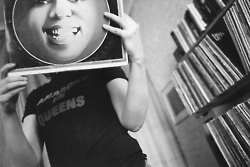
(Photo of Ellen Willis (with Bessie Smith), feminist and music journalist stoled from Ellen Willis tumblr)
That was made quite clear when I bitched (yet again) about the lack of women jazz journalists on twitter. @hawleyrose suggested I talk to @elementsofjazz (herself a woman jazz writer), who then hooked me up with Nate Chinen’s article On women in jazz (criticism) and Angelika Beener’s article Nice Work If We Can Get It: Women Writing on Jazz. Then I followed a million links from each of those articles to many more articles. The bottom line, here is that I mouthed off without researching the topic properly. I fell into that old ‘invisible women’ trap. Because I didn’t see women writing for big name jazz publications, I figured they didn’t exist. Just like that arsehat who recently bleated that there weren’t any women bloggers or tweeters writing about politics. With that bloke, the problem was a) that he defined ‘politics’ using the usual, very limited party-politics-institutions-and-polls definition and b) that he didn’t bother with bloggers and tweeters outside his usual sphere.
So my problem was a) I wasn’t looking in the right places (I was only looking in the conservative ‘official’ jazz journalism public sphere), and b) I hadn’t bothered to do much work to find those women journalists. Now I know better. And I’m delighted to be wrong. There are lots of women jazz journalists. Particularly when you broaden your definitions and include independent media, especially online media.
I think it’s worth talking about the history of jazz criticism here. And how small independent print publications were so important to the development of jazz criticism and writing from the turn of the century. But it’s also worth giving an eye (or ear) to the larger print publications like Esquire and Downbeat. I’ve written about this before, quite a few times, so I won’t go into it here (search for ‘magazines’ and you’ll find some old posts, or follow the links from More Esquire Talk).
What I do want to say, here, is that I’ve been thinking perhaps I should be asking “Are there any women writing about early jazz?” I’m wondering if the usual industrial and labour divisions of the early 20th century made it harder not only for women to get published, but for women to get read in the early days. And if there’s a resistance to writing about early jazz in the modern jazz publications and sites. Surely I’m once again voluntarily making women writers invisible. Surely. Time for more research, yes? YES!

The three of us were DJing a recent dance with lots of performances, and were a little less than attentive during the pre-dance class.